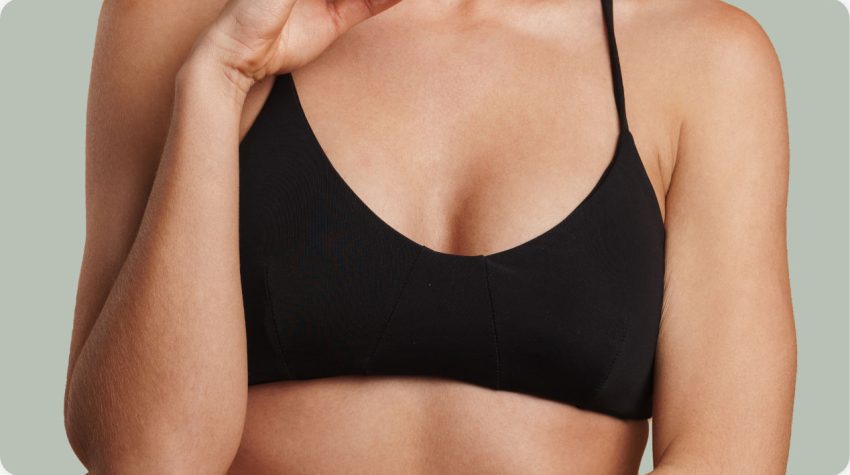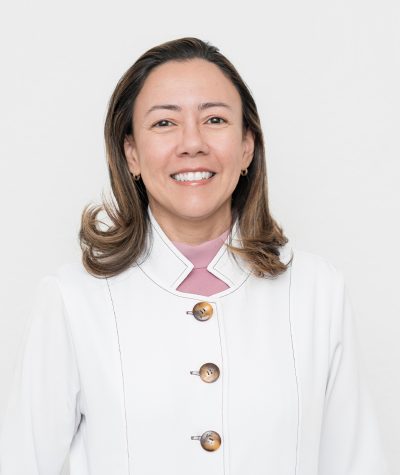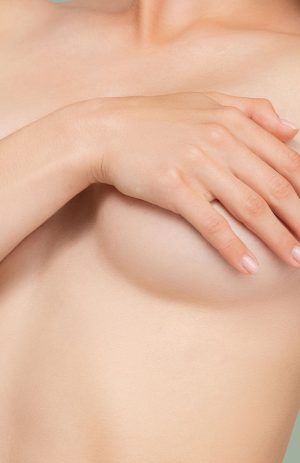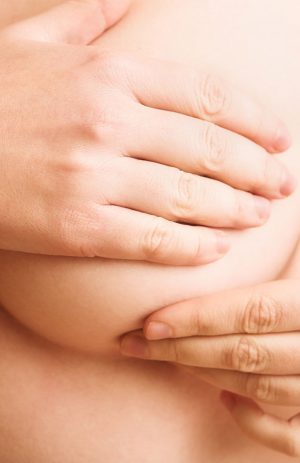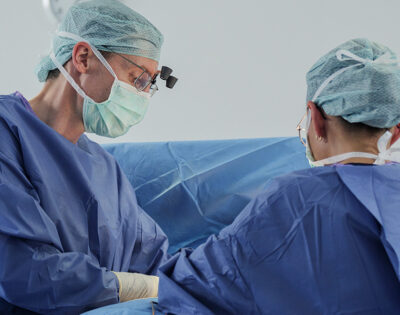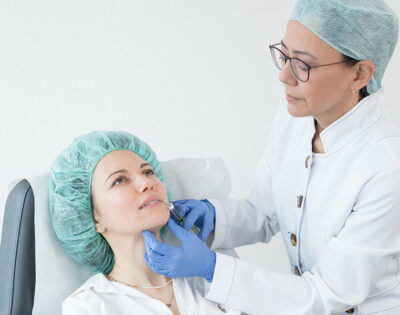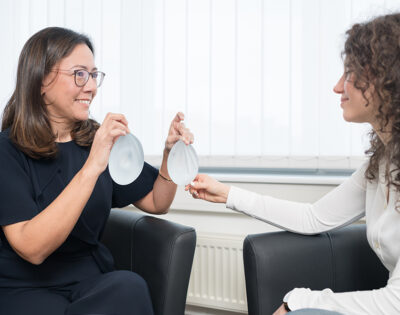Breast augmentation with implants: finally feeling good again
The appearance of the female breast, its size and shape are, among other things, a central part of your female identity. Would you like to be able to wear any dress you like? Do you feel unattractive because of small breasts? The reasons for breast augmentation with implants are individual and very different. Below we explain what you should know about breast augmentation with implants.
Choose a neckline that suits you:
- Finally being able to wear low-cut dresses
- Bringing the body into balance through the right proportions
- Increasing attractiveness through breast augmentation
- Being able to do without annoying push-up bras
What our patients say
Information at a glance
Operation duration
1 hour
Aftercare
6 weeks
Anesthesia
Twilight sleep
Thread tension
Self-dissolving threads
Hospitalization
Outpatient
Socially acceptable
after 5 days
Costs
Additions or alternatives
Hybrid breast augmentation / Breast augmentation with autologous fat
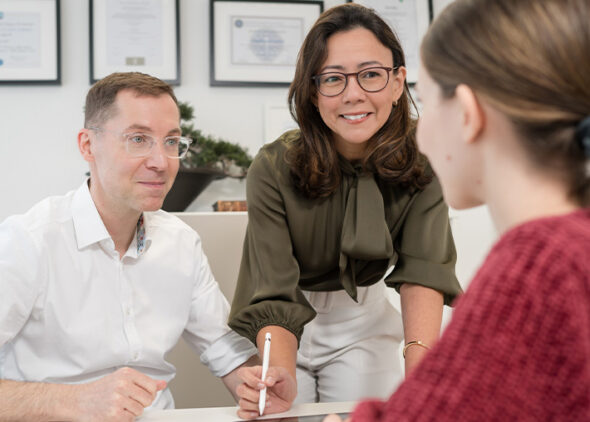
Implant calculator
Determine your implant size free of charge
Reasons for breast augmentation with implants
Frequently expressed wishes include a more feminine silhouette, a natural balance to the rest of the body, a better love life, wearing clothes without worrying and a more attractive appearance. Do you feel the same way?
Aesthetic breast augmentation:
Breast augmentation is one of the most common aesthetic procedures worldwide. It is estimated that over 1.5 million breast augmentations were performed in 2017. Scientific studies have shown that breast augmentation is generally associated with a high level of patient satisfaction and a significant improvement in quality of life.
Breast augmentation using implants is one of the classic medical procedures in plastic and aesthetic surgery that makes it possible to achieve the desired size.
After pregnancy:
Perhaps the following sounds familiar to you? Women often want to regain the lost volume of their breasts and their previous cup size after pregnancy or significant weight loss. If breast shape correction is desired at the same time, breast augmentation can also be combined with a breast lift. So you can have both.
On this page you will find detailed information on surgical methods for breast augmentation with implants and receive help in choosing the right implant for your needs. In addition, frequently asked questions are answered and you will receive a lot more information and details that you should be aware of if you want a safe breast augmentation with a natural appearance. You can of course contact us for an initial consultation to draw up an individual treatment plan.
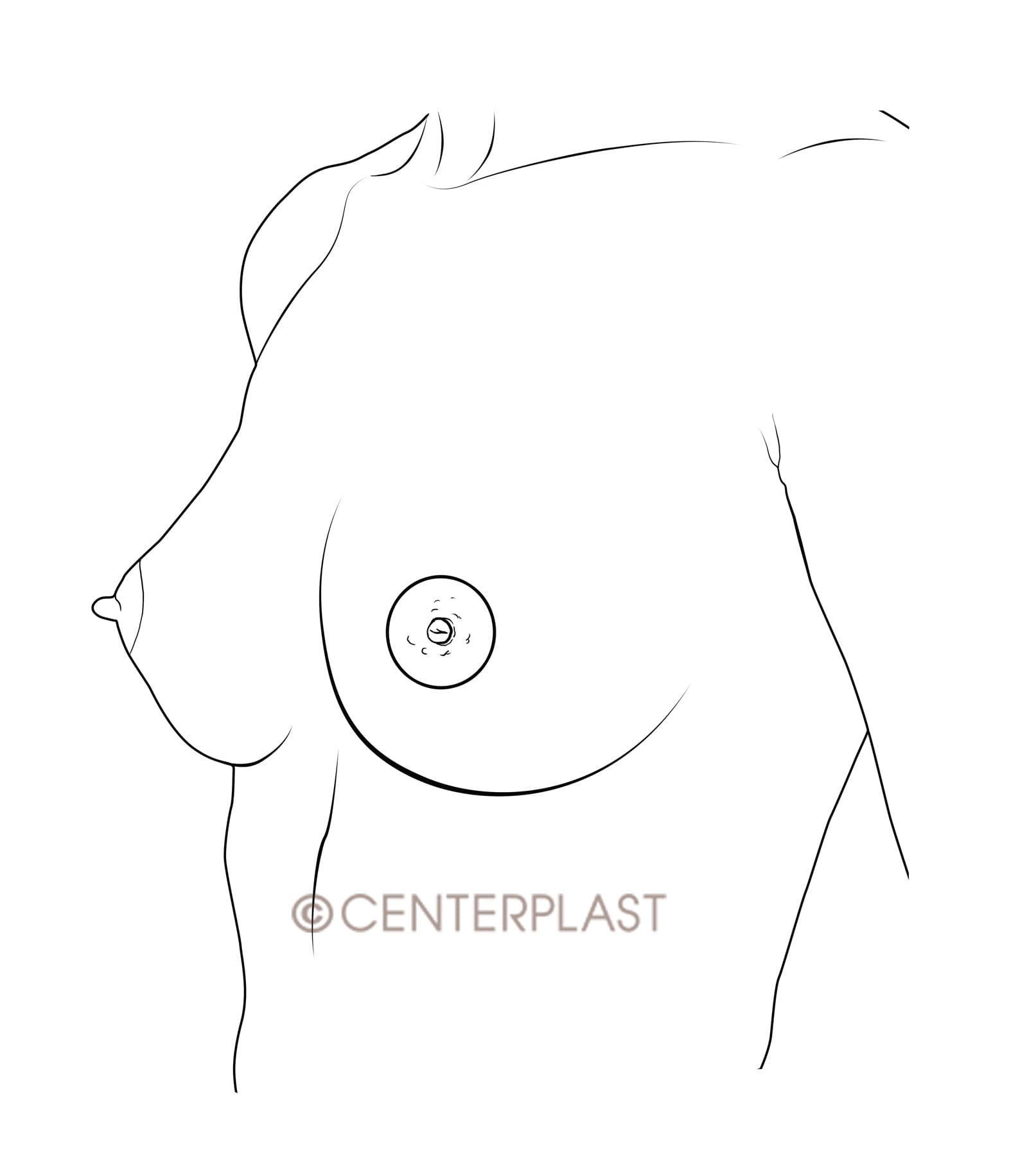
Beautiful proportions of the female breast
Harmonious proportions and symmetry of the breast are perceived as beautiful and sensual. The shape, size and position of the nipple on the breast are key features that influence the perception of beauty.
What you should know about breast implants
Implants are selected according to their shape, i.e. whether they are anatomical (teardrop-shaped) or round, as well as their size, outer wall and filling material. CE and FDA certifications testify to compliance with European and American quality standards. To select the right implant, your desired changes and the individual anatomical conditions of your body should be taken into account.
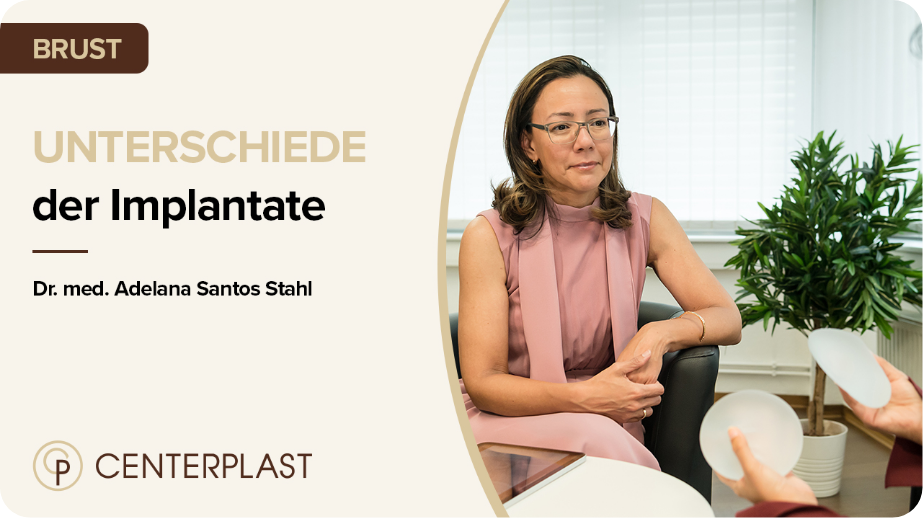
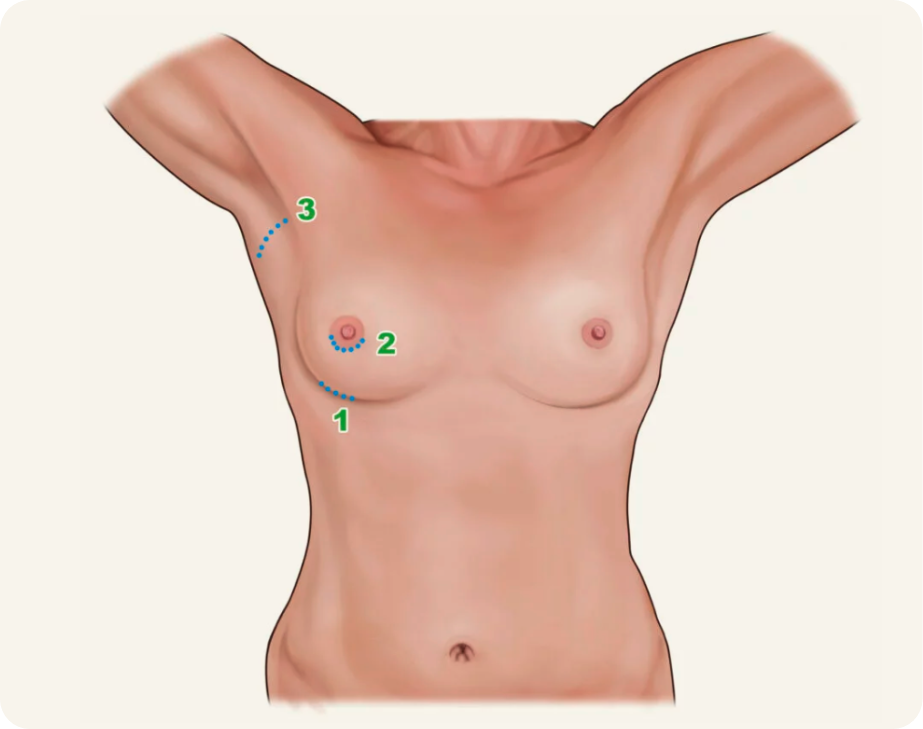
Implants can be inserted into the breast in various ways via small incisions in the skin. Each route, also known as access, has different advantages and disadvantages. The access in the underbust fold (1), the access around the areola (2) and the access via the armpit (3) are shown.
Which reference points are used in your breast examination?
You can probably relate to this: Changes in the shape of the breasts and bust size can be emotionally stressful after puberty or later in life. Certain features and proportions are generally associated with beauty, harmony, youthfulness and health. In order to get a comprehensive picture, various reference points are measured during the investigation. These individual differences are taken into account when drawing up a treatment plan.
- Collarbone center
- Thrush pit (Jugulum)
- Neckline
- Upper inner chest quadrant
- Gutter between the breasts
- Nipple
- Chest base
- Underbust crease
- Elbow bend
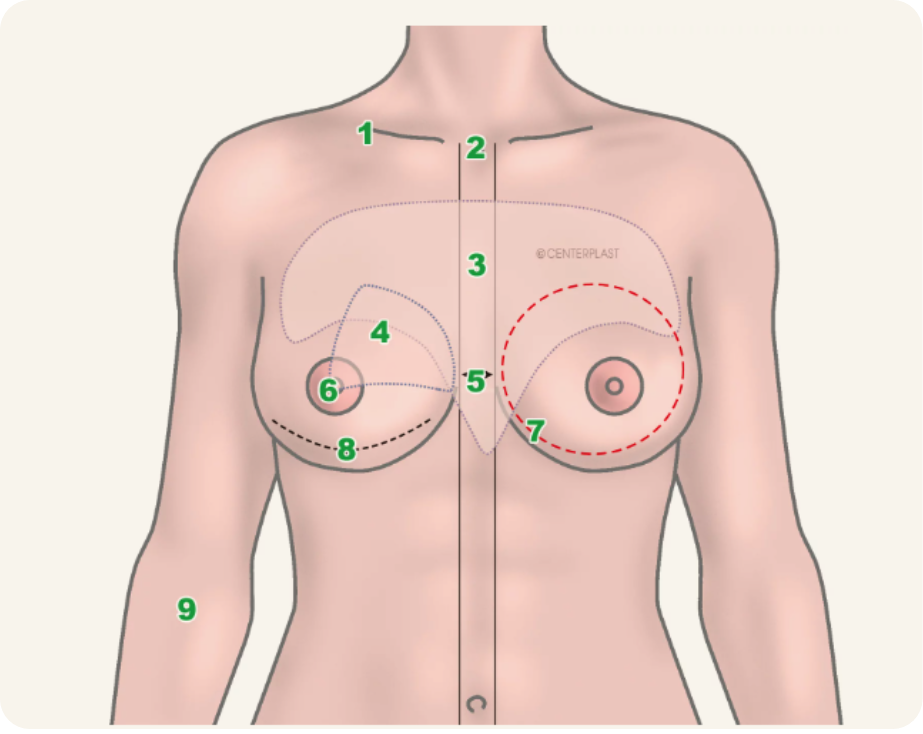
How we select the right breast implant for you
When choosing the right implant, decisions must be made regarding the shape (round or teardrop-shaped), the projection (implant thickness), the surface (outer wall), the filling material (inner material), the degree of strength, the manufacturer and the size. We will be happy to advise you on how to achieve the visual result of a natural breast in the desired size. Take a look here at which implants can be used for breast augmentation.
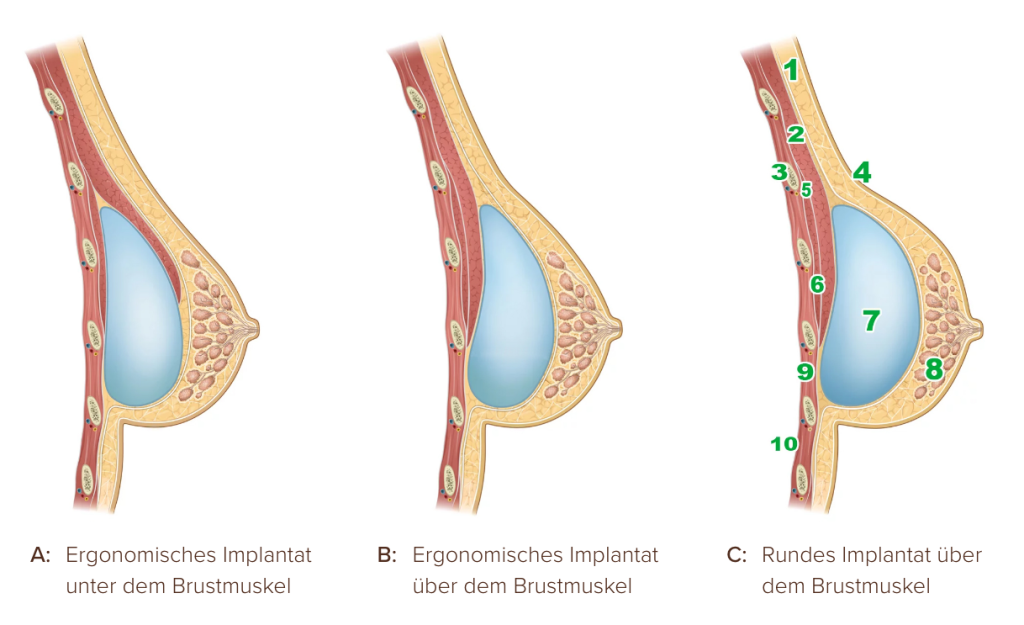
- Subcutaneous fatty tissue
- Large pectoral muscle
- Third rib
- Neckline
- intercostal nerves
- Small pectoral muscle
- Round implant
- Mammary gland
- intercostal muscle
- Outer pleura
The position and shape of a breast implant affect the contour of the breast. Teardrop-shaped (anatomical) implants have more volume in the lower half of the breast (breast pole). These implants offer you the advantage of a natural transition in the décolleté. In contrast to round implants, teardrop-shaped breast implants have a rough surface to maintain their orientation (more volume at the bottom than at the top). The rough surface is suspected of causing blood cancer in rare cases. To make the implant less visible or palpable in the décolleté, it can be inserted under the large pectoral muscle. The large pectoral muscle is large enough to cover the entire implant in only a quarter of women (Madsen et al., 2015, Ann Plast Surg). In most cases, the origin of the large pectoral muscle extends to the 6th rib. The origin of the small pectoral muscle extends from the third to the fifth rib.
Breast implant facts
Anatomical breast implants or implants in teardrop shape: natural shape, possible risk of twisting the implant. Anatomical breast implants therefore have a rough surface.
Round breast implants: fuller cleavage. Round implants can therefore have a smooth surface.
Anatomical breast implants or implants in teardrop shape: natural shape, possible risk of twisting the implant. Anatomical breast implants therefore have a rough surface.
Medium projection: most natural results.
Round breast implants: fuller cleavage. Round implants can therefore have a smooth surface.
High projection: tends to be a full shape.
Anatomical breast implants or implants in teardrop shape: natural shape, possible risk of twisting the implant. Anatomical breast implants therefore have a rough surface.
Silicone sheath with smooth surface: access tends to be smaller, increased risk of capsular contracture.
Round breast implants: fuller cleavage. Round implants can therefore have a smooth surface.
Silicone sheath with smooth surface: access tends to be smaller, increased risk of capsular contracture.
Anatomical breast implants or implants in teardrop shape: natural shape, possible risk of twisting the implant. Anatomical breast implants therefore have a rough surface.
Silicone: generally dimensionally stable material, lower risk of wrinkling.
Round breast implants: fuller cleavage. Round implants can therefore have a smooth surface.
Physiological saline solution: low dimensional stability, increased risk of wrinkling.
Anatomical breast implants or implants in teardrop shape: natural shape, possible risk of twisting the implant. Anatomical breast implants therefore have a rough surface.
Low strength: more natural shape, lower projection.
Round breast implants: fuller cleavage. Round implants can therefore have a smooth surface.
High firmness: unnatural shape especially when lying down, high projection.

- Nagor® / Shape: round; Implant thickness: high profile; Outer wall: micro-structured; Volume: 240 ml
- Eurosilicone® / Shape: round; Implant thickness: high profile; Outer wall: smooth; Volume: 350 ml
- Eurosilicone® / Shape: teardrop-shaped; Implant thickness: moderate projection; Outer wall: micro-structured; Volume: 235 ml

- Motiva Ergonomix® / Shape: ergonomic; Implant thickness: Corsé; Outer wall: micro-structured; Volume: 380 ml
- Motiva Ergonomix® / Shape: ergonomic; Implant thickness: demi; Outer wall: micro-structured; Volume: 300 ml
- Motiva Round® / Shape: round; Implant thickness: demi; Outer wall: micro-structured; Volume: 300 ml
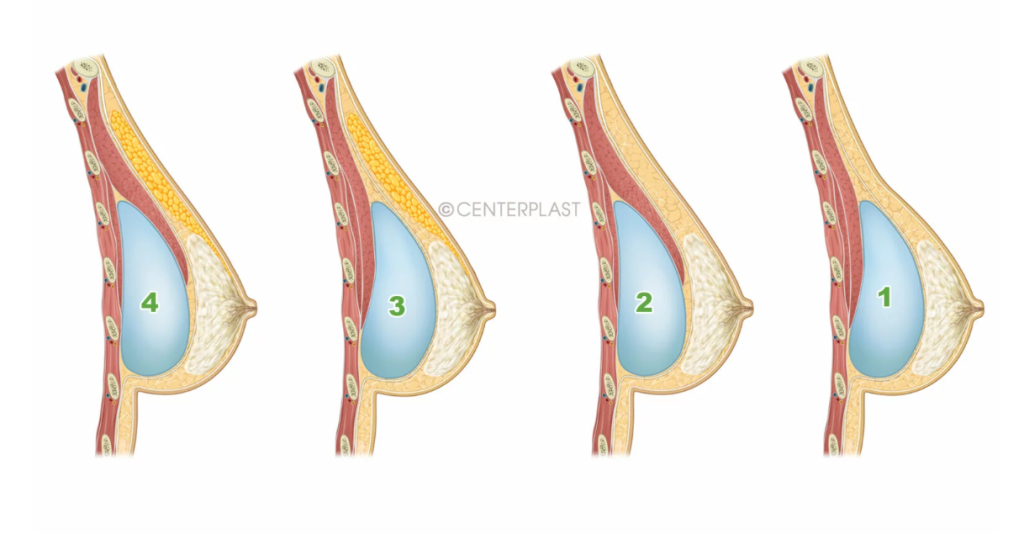
Breast augmentation (1) can be performed in different ways and can be combined with autologous fat treatment. The different types of breast augmentation create different cleavage fullness. For a smooth and natural transition between the upper breast border and the collarbone, the implant can be inserted below the pectoral muscle (2). Alternatively, breast augmentation can be combined with autologous fat treatment (3). For more fullness of the décolleté, an autologous fat treatment can be performed in addition to the position of the implant under the pectoral muscle (4).
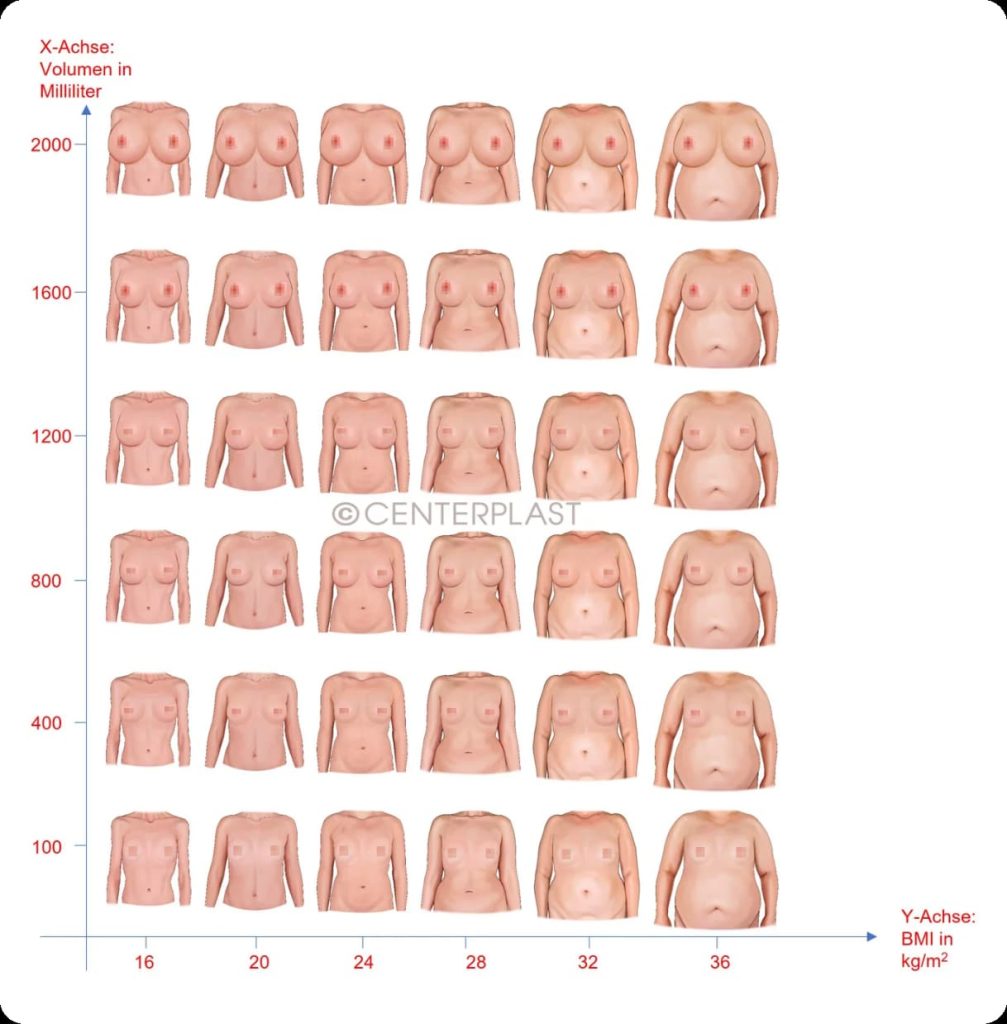
The size of a woman’s breast is naturally in proportion to her physique. Different sizes of female breast occur in different frequencies in the population. Average sizes are the most frequently occurring sizes. The most frequently occurring sizes correspond to the images of the diagonal from bottom left to top right in the image. For a natural result, we recommend aiming for an average-sized breast.
Los Deline© liquid implant
The Los Deline© tissue filler was developed in 2005 and initially marketed under the name Aquafilling© (Biomedica, Prague, Czech Republic). The colorless, transparent gel consists of 98% saline solution and 2% of a multiple bond of acrylamide and N,N′-methylenebisacrylamide. There may be minimal differences in the bonding structures between the structure of Los Deline© and other polymethyl methacrylate (PMMA) tissue fillers. However, the overall composition of these tissue fillers appears to be very similar 1 . With other PMMA tissue fillers (e.g. Aquamid®), complications such as inflammation, pain and lump formation were seen in over 18 percent of cases 2 . The complications of Aquafilling© occur between 5 months and 12 years after the injection (on average 3 years).
The complications sometimes have to be treated by surgery. The reasons for surgery are hardening in over 80 percent, pain in over 50 percent and inflammation in 7 to 8 percent (Cheng N, et al. 2002, Aesthet Plast Surg). Enlarging a breast by injecting a liquid implant is tempting. All too often, these treatments are offered by doctors who, unlike plastic surgeons, are not proficient in alternative breast augmentation techniques. Non-invasive procedures are neither harmless nor without risk for you. Tissue fillers for breast augmentation were therefore banned by the US Food and Drug Administration (FDA) in 2015 3 . As the term cosmetic surgeon is not protected, there are also providers of highly dubious methods of breast augmentation, such as a 24-hour push-up augmentation with a saline solution filling. We therefore recommend that you not only question the quality of the implant, but also research the qualifications of the doctor you are entrusting yourself to. Always rely on the latest generation of high-quality implants. The combination of modern implants and experienced specialists in aesthetic surgery are the basic prerequisites for success. Get comprehensive information.
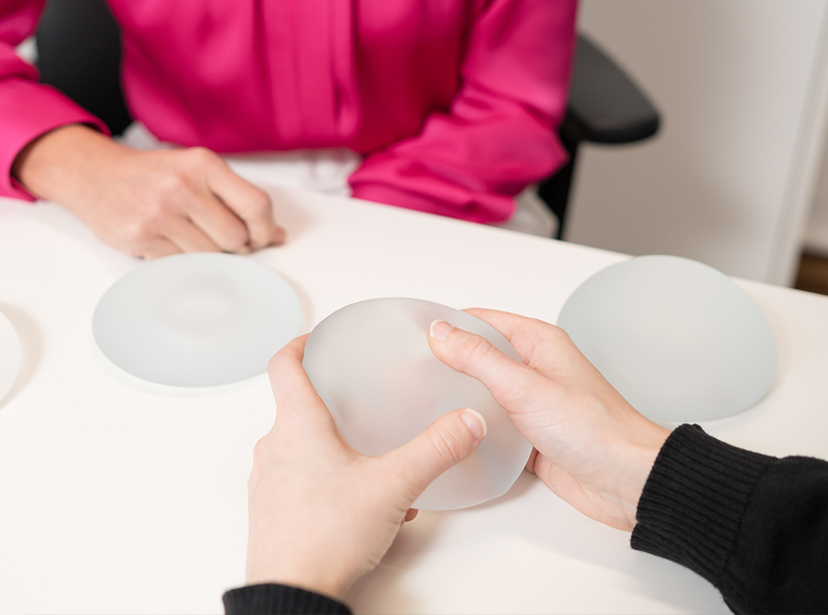
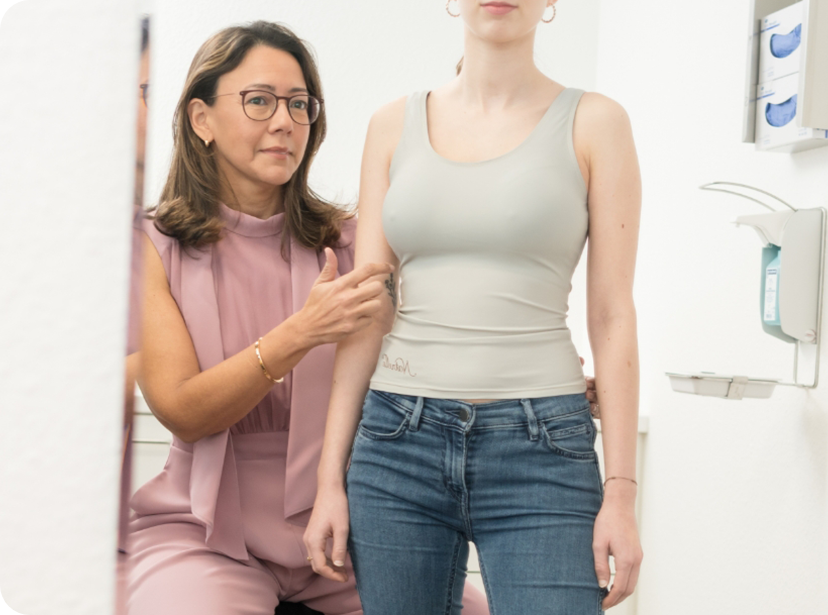
The implants can be inserted via these routes and access points
Advantages
- Good overview
- The implant can be placed under the pectoral muscle.
- Use of an anatomical implant possible.
- Implant change possible via the same access
- Breastfeeding ability not impaired
Disadvantages
- Scar visible when lying down or, in the case of small breasts, also when standing up
Advantages
- Inconspicuous scar
Disadvantages
- Not possible with small nipples or large implants
- Breastfeeding ability may be impaired
- Possible loss of sensation in the nipple
- Additional scar in the underbust fold for implant replacement
Advantages
- No scar on the breast itself
- Advisable if there is a tendency to scar growths
- Advantageous for small to moderate enlargement of small breasts
- Breastfeeding ability not impaired
Disadvantages
- Precise placement of the implant made more difficult
- Increased risk of asymmetrical underbust folds
- Keyhole technology with limited overview
- Risk of damage to the cutaneous nerves of the arm and lymphatic vessels
- Interferes with the examination of sentinel lymph nodes for the detection and treatment of breast cancer
- Additional scar in the underbust fold for implant replacement
- Expensive equipment required
Breast augmentation procedure
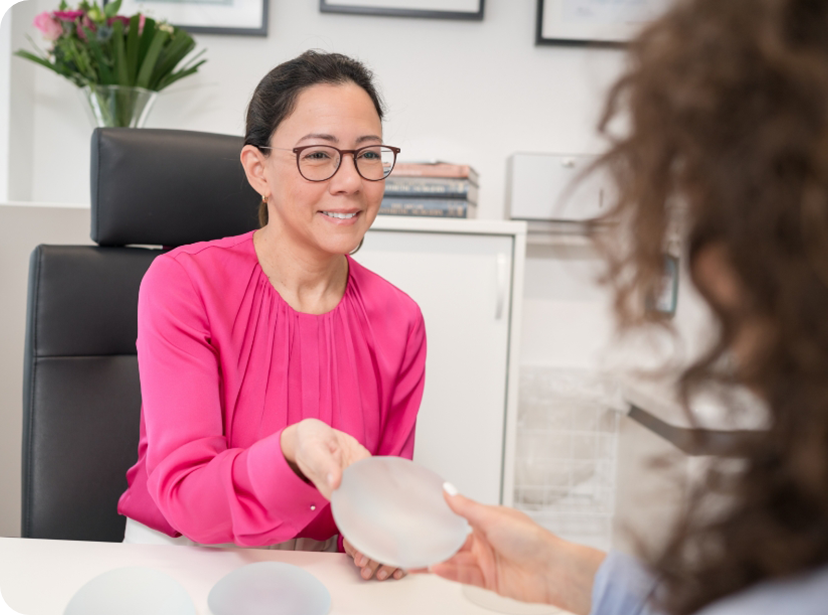
Preparation
Before starting, a before picture (photo with specific settings) is taken so that you can optimally compare the result.
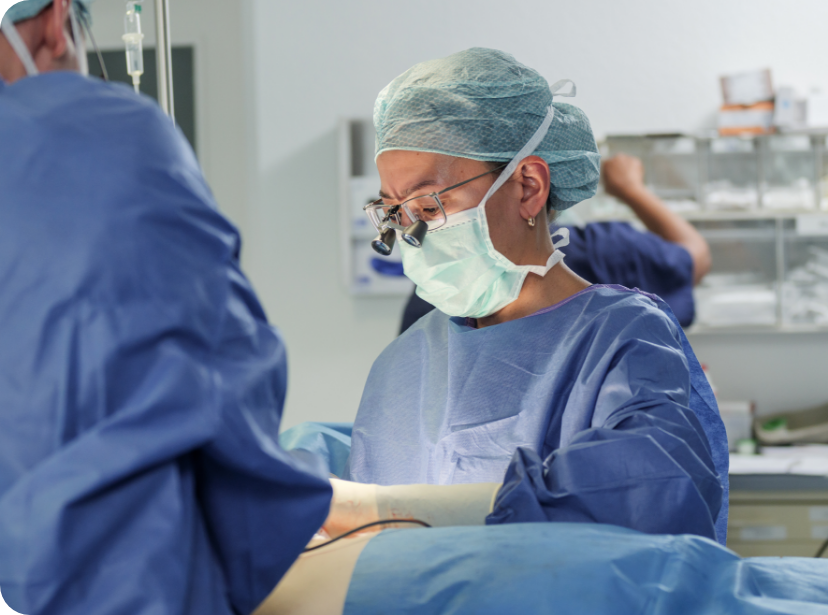
The OP
The medical procedure is not only performed under local anesthesia, but also under general anesthesia as part of an outpatient procedure in the practice, in a special operating room.

After the procedure
The wound after the operation is mainly sutured with self-dissolving skin sutures. Depending on the findings, drainage tubes may be inserted into the wound in the operating room during breast augmentation surgery, which can be removed again after a short period of time. The duration of the operation, including general anesthesia, is approx. 60 minutes. You will receive an implant passport / implant ID card in accordance with the legal requirements. In this way, the origin of the implants can be traced back to the manufacturer at any time.
What you should consider before and after breast augmentation with implants
You should observe the following instructions after breast augmentation with implants.
- Only sleep on your back for the first 6 weeks to avoid any risk of the implants slipping.
- The result is secured by wearing special bras: The implant is fixed in place.
- Avoid fast, sweeping and powerful shoulder movements. These could cause the breast implant to slip or twist. Chest muscle training should be paused for six weeks.
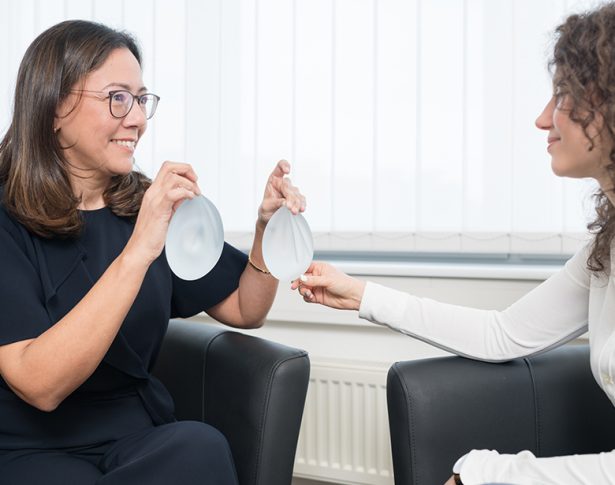
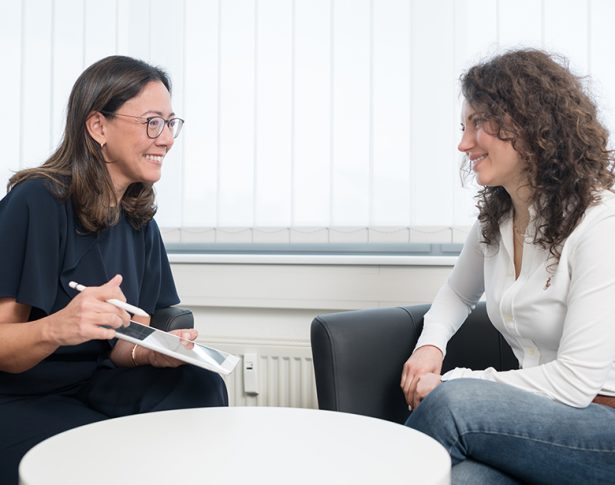
Breast augmentation simulation
3D simulations and VR glasses have become very popular in recent years. The problem with the current algorithms is that they feign an accuracy that is not realistic, especially when combining different methods. The variety and complexity of breast augmentation are not covered by most programs.
We develop an individual treatment plan for you, which can include various techniques such as autologous fat treatment, tightening of the skin mantle or correction of fat pads in front of the armpits. As current simulation programs are not able to show such changes, we explain the expected changes in before and after pictures during the consultation. We also offer you the option of using silicone bra inserts to get a feel for resizing before an operation.
Our before and after pictures of a breast augmentation with implants
When undergoing cosmetic surgery, many patients expect to be able to view before and after pictures (after pictures / before and after photos). When it comes to breast augmentation with implants, women naturally insist on putting themselves in the hands of an exceptionally trustworthy expert in plastic and aesthetic surgery in order to receive detailed and competent individual advice.
They want to make sure that they will be completely satisfied with the result and get an idea of it in advance. In this context, they also expect to be shown before and after pictures (before and after photos) of any operations that have been carried out. You can view such photos for a before-and-after comparison during a personal consultation. Of course, this is done in compliance with data protection regulations. In addition, a trial bra is put on at the appointment so that you can visualize the target size.
Do you have textured breast implants? These recommendations are for you:
Feel your breasts regularly. After the age of 30, you should have your breasts and armpits examined by a gynecologist every year. After the age of 50, an annual mammogram is recommended for you. Ultrasound or MRI examinations may be necessary if the mammography examination is not conclusive enough. An immediate examination by a plastic surgeon is required if you notice a change in the size, feel or shape of your breasts.
FAQ – Frequently asked questions
The cost of breast augmentation with implants is determined during the personal consultation. If you would like to get an idea of the price in advance, please visit our cost page .
The patient’s preference and a harmonious relationship to the circumference of the waist and hips are decisive for the optimum bust size. The width of the rib cage and the amount of subcutaneous fatty tissue must also be taken into account. If relatively large implants are chosen for a narrow chest, the implant can become visible and palpable at the sides (also known as the rippling phenomenon).
In very thin or very athletic patients, there is often very little fatty tissue under the skin. This should be considered when selecting the size of the implant, the shape of the implant and the choice of surgical technique. Otherwise, implants that are too large in the décolleté look unnatural, as if they have been put on. Clothing sizes differ significantly from manufacturer to manufacturer. Although there are studies that assume an increase in volume of around 200 ml with an increase in cup size from B to C or from C to D, these values are only a rough guide [14]. In fact, the volume increase from a bra size 75B to 75C varies from 85 to 230ml depending on the manufacturer, from 75C to 75D from 100 to 140ml and from 75D to 75E from 80 to 180ml [15].
Most patients have very precise ideas and expectations regarding the desired bust size. Since there is no standard bra cup size, the idea of a C or D cup for a patient wearing Victoria’s Secret® brand bras is very different from that of a patient wearing Triumph® brand bras. It is not uncommon for these misunderstood expectations regarding cup size to lead to great dissatisfaction after the operation. That’s why we take the time our patients need to explain the goals and limitations of breast augmentation in detail.
Silicone implants have no expiry date. And yet there is no lifetime guarantee for breast implants filled with silicone gel. They do not last a lifetime. Despite continuous further development of the shells and the filling (silicone), the shell of an implant can subsequently develop a crack. As a rule of thumb, the American Society for Aesthetic Plastic Surgery (ASAPS) puts the risk at one percent per year. Other reasons for follow-up surgery after breast augmentation include implant slippage (37 percent), capsular contracture (33 percent) or the patient’s desire for a different implant size (20 percent)[16].
The risk of slippage is greater if the implant is inserted under the pectoral muscle rather than over it. Capsular contracture is the formation of scar tissue around the breast implant, which appears as hardening, deformation or pain in the breast. Capsular contractures develop in about 10 percent of women after 10 years[17]. The implant surface, the placement of the implant and certain precautions during the surgical procedure influence the risk of capsular fibrosis.
The risk of another breast operation varies from ten percent two years after breast augmentation to 20 percent after six to ten years[18]. The reasons for removing implants can also be concerns about BIA-ALCL (breast implant-associated anaplastic large cell lymphoma) or BII (breast implant illness) and therefore a medical indication. The larger the implant, the greater the subsequent risk of slippage, injury to the shell or capsular contracture. The additional treatment with autologous fat in hybrid breast augmentation offers many advantages. The additional breast augmentation with autologous fat makes it possible to choose a smaller implant. In this case, the breast feels more natural. If necessary, the expert plastic surgeon can shape or correct the breast more individually. It is also possible to emphasize the décolleté.
This is one of the most frequently asked questions. The increase in breast size can be seen immediately after the operation, so that you already have an initial picture of it. The swelling that is unavoidable in the first few days disappears after a few weeks and the exact shape of the contour can then be recognized more precisely. However, it takes a few months for the skin’s elasticity to adjust and for the scars to heal.
The final shape of the breast therefore takes some time to emerge. The scar is often slightly reddened or raised in the first few months. Consistent massage of the scar and the application of a silicone plaster three to four weeks after the surgical procedure promote and accelerate the healing process, allowing the scar to heal inconspicuously. Age, state of health and the size of the selected implant influence the duration of healing. In 90 percent of patients, the final result can be seen three months after breast surgery, although this naturally varies slightly from patient to patient.
The FDA recommends an MRI examination in an appropriate clinic approximately three years after the operation and then every two years. This medical examination can detect ruptures of any kind that would remain undetected at first glance even during a physical examination by a doctor.
There are two main reasons for this: Firstly, studies indicate that capsular contractures (formation of firm scar tissue around the implant) occur less frequently with rough surfaces compared to smooth surfaces. Secondly, all teardrop-shaped implants / anatomical breast implants have a rough surface to prevent them from slipping. Some surgeons believe that anatomically shaped implants, as opposed to round implants, result in a natural breast shape.
The CE certification of textured implants from the manufacturer Allergan was not renewed on 17.12.2018. On 5.04.19, textured implants from the following manufacturers were banned in France: Allergan Inc, Laboratoire Arion, Nagor Ltd, Eurosilicone, Polytech Health & Aesthetics, Sebbin. American and German professional societies do not advise against the use of such implants. Patients in Germany can decide to use these implants after being fully informed about the risks and alternatives.
The implant is removed in one piece with the capsule. For en-bloc removal, a larger access in the area of the underbust fold is required. Removal of the implant en bloc is associated with a higher risk of injury to the ribs, muscles or lungs.
BIA-ALCL is not a cancer of the breast tissue itself, but a form of blood cancer that affects the white blood cells. A connection between the development of anaplastic large cell lymphoma (ALCL) and breast implants is considered certain. Alternative procedures (breast augmentation with autologous fat) should therefore be considered.
Most cases of anaplastic large cell lymphoma occurred with implants with a roughened (textured) surface. For this reason, the CE certification of textured implants from the manufacturer Allergan was not extended on December 17, 2018. On 5.04.19, textured implants from the following manufacturers were banned in France: Allergan Inc, Laboratoire Arion, Nagor Ltd, Eurosilicone, Polytech Health & Aesthetics, Sebbin.
For smooth surfaces only in very rare cases: 0.0001% (1:704,000)
- For fine rough surfaces (microtextured implants, Siltex® and similar): 0.001% (1:82,000)
- For coarse rough surfaces (macrotextured implants, Biocell® and similar): 0.031% (1:3,200)
- With a polyurethane coating: 0.035% (1:2,800)
The following figures may help to better classify the risk of developing BIA-ALCL after breast augmentation with silicone implants.
- Risk of rupture of an implant over a period of 10 years: 8.7% (1:11.5).
- Risk of capsular contracture over a period of 10 years: 13.5% (1:7.4).
- Risk of reoperation over a period of 10 years: 31.6% (1:3).
- Risk of developing breast cancer over a woman’s entire lifetime: 12.5% (1:8).
- Risk of breast cancer recurrence after mastectomy for breast cancer: 5% to 8% (1:12.5-20).
- Lifetime risk of being killed in a car accident: 0.15% (1:645).
- Risk of a life-threatening complication during aesthetic surgery: 0.002% (1:50,000).
- Risk of developing advanced BIA-ALCL with lymph node metastases after breast augmentation with silicone gel implants: approx. 0.0004% (1:250,000).
- Risk of developing BIA-ALCL after breast augmentation with silicone implants that is not treated within 3 months: 0.0002% (1:500,000) [24] .
The first symptom of BIA-ALCL is swelling of the breast, which occurs on average eight years after the insertion of breast implants (ranging from two to 28 years after breast surgery). The swelling is due to an accumulation of fluid surrounding the implant. This fluid can cause the breast to become significantly larger over a period of days or weeks. There may also be lumps in the breast or armpit, firmness of the breast or pain. BIA-ALCL is usually easily treatable and curable if patients seek treatment immediately after the first symptoms appear.
Since the disease was first reported almost 20 years ago, there have been 16 confirmed deaths worldwide. If BIA-ALCL is detected early, before it develops into a lymphoma, it is easily treatable and curable by removing the implant and the surrounding scar or capsule.
If BIA-ALCL is detected early, it is easily curable. Current recommendations for the treatment of BIA-ALCL include bilateral capsulectomy (removal of all scar tissue) and removal of the breast implants. Such procedures are also performed by plastic surgeons if an implant is damaged or a capsular contracture has developed. The majority of patients do not require any additional treatment. However, if the BIA-ALCL has spread to the lymph nodes or adjacent tissue in the body, chemotherapy or radiotherapy may be necessary.
Neither the Federal Institute for Drugs and Medical Devices nor the German professional associations or the US Food and Drug Administration (FDA) recommend the preventive removal of implants with a rough surface. However, there are women who decide to have their implants removed due to concerns about BIA-ALCL.
If the implants are to be removed due to concerns about the BIA-ALCL, the following options are available to achieve a beautiful breast shape afterwards:
If the implants are to be removed due to concerns about the BIA-ALCL, the following options are available to achieve a beautiful breast shape afterwards:
- Replacement of the previous implants with new implants with a smooth surface.
- Breast augmentation through treatment with autologous fat, which usually has to be repeated three times.
- A breast lift.
There is no blood test that can detect BIA-ALCL. According to experts, women who have no changes in their breasts do not need any additional examinations. However, if a patient has noticed a change in her breasts, such as a swelling or lump – an examination, imaging and consultation (in person) with a plastic surgeon should be arranged immediately. If there is fluid around the implant, the fluid should be aspirated under ultrasound guidance and sent for analysis.
Plastic surgeons, scientists and implant manufacturers are working intensively on this issue. Possible risk factors are the implant surface and chronic inflammation (germs called Ralstonia picketti, pseudomonas, brevundimonas). As very few cases have been reported in some regions of the world (e.g. Asia), a hereditary predisposition is also being discussed as a favorable factor. Various factors may have to come together for a BIA-ALCL to develop after some time.
It is estimated that 1.5 million breast augmentations with implants were performed worldwide in 2017. Nevertheless, breast implant disease is a rare and still insufficiently researched disease. Other names for breast implant disease are “autoimmune/inflammatory syndrome induced by adjuvants (ASIA)” or “Silicone Implant Incompatibility Syndrome (SIIS)”. A connection between breast implants and very inconsistent complaints has been discussed for around thirty years. These symptoms include joint pain, fatigue, chest pain, hair loss, headaches, chills, sensitivity to light, digestive problems, night sweats, skin rashes, weight gain, palpitations, body odor, anxiety, concentration problems, sleep disorders, depression, neurological and hormonal problems. These complaints are described regardless of the manufacturer of the breast implants, the surface of the implant (rough surface or smooth surface) and the filling material (physiological saline solution or silicone). There are numerous reports about this on social media.
Silicones are artificially produced compounds. The compounds consist of silicon (Si) linked together in chains with oxygen (O) and two organic hydrocarbon groups. Silicon is the third most common element on earth after oxygen and iron. In nature, silicon occurs in combination with oxygen as silica (silicon dioxide). Silicon dioxide, also known as E551, is also approved as an additive for organic foods. E551 is found in instant coffee, sliced cheese, grated cheese, seasoning powder, packet soups and table salt. The inhalation of silicon dioxide as fine dust can lead to quartz dust lung and an inflammatory disease of the joints (Caplan syndrome). These are occupational diseases in miners, stonemasons or cast iron cleaners. Silicone is found in deodorants, skin and hair care products, ointments, lubricants and baking tins. In medicine, silicone is used in pacemakers, heart valves, artificial joints and breast implants. Antioxidants, colorants and plasticizers are removed from medical silicone during production.
In the early 1990s, there were several case reports linking silicone implants to connective tissue disorders, cancer and autoimmune diseases. The use of silicone implants was stopped in the USA in 1992. A US non-profit and non-governmental organization (National Academy of Medicine) has denied a risk after evaluating 1078 scientific reports[27]. In 2006, the US Food and Drug Administration (FDA) re-approved silicone implants. Causal relationships are examined in medicine according to the Hill criteria.
Intensive research is being carried out on such a test. However, laboratory tests are available to detect certain autoimmune diseases.
The improvement after the removal of breast implants may be absent, temporary or permanent. There is no study that proves that implant removal with capsulotomy is better than without capsulotomy.
There is no way to prove or disprove the connection between the complaints and the breast implants afterwards. We recommend a consultation with a specialist in internal medicine and rheumatology. If an autoimmune disease can be detected, drug treatment may be recommended. The implants used can be removed with or without the capsule (en-bloc) at any time.
As the connection is not (yet) considered certain, it is currently not possible to speak of a risk. To the best of our knowledge and belief, there is no evidence from high-quality studies of a link between breast implants and autoimmune diseases.
The implant is removed in one piece with the capsule. For en-bloc removal, a larger access in the area of the underbust fold is required. Removal of the implant en bloc is associated with a higher risk of injury to the ribs, muscles or lungs.

AUTHOR
Dr. Stéphane Stahl
We provide you with extensive expert knowledge in order to select the best possible treatment path together with you.
Privatdozent Dr. med. Stéphane Stahl is the former Director of the Clinic for Plastic, Reconstructive and Aesthetic Surgery / Hand Surgery at Lüdenscheid Hospital. Dr. Stahl studied medicine at the Universities of Freiburg and Berlin.
He passed the European specialist examination for plastic and aesthetic surgery in 2011 and the German specialist examination in 2012. This was followed by further specialist qualifications and additional qualifications (including quality management, medical didactics, physical therapy, emergency medicine, laser protection officer, hand surgery) as well as prizes and awards.
In 2015, he completed his habilitation in plastic and aesthetic surgery in Tübingen. He is an experienced microsurgeon, sought-after expert witness and regular speaker at specialist congresses. Following a multi-stage selection process, Stéphane Stahl became a member of the American Society for Aesthetic Plastic Surgery (ASAPS), one of the world’s largest and most influential specialist societies for aesthetic surgery.
His authorship includes numerous articles in prestigious peer review journals and standard surgical textbooks.
You might also be interested in

Personal advice
We take time for you and offer you customized advice and treatment for your individual result.
